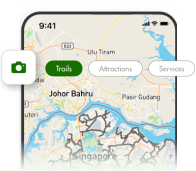Singapore has a diversity of land and freshwater ecosystems, ranging from forests to urban parks and freshwater habitats.
These ecosystems are home to numerous plant and animal species, each playing a critical role in maintaining ecological balance. Some ecosystems also contribute to urban planning and water management.
Find out more about each ecosystem type:
Forests
Lowland mixed dipterocarp primary forests

These forests are made up of tall dipterocarp trees such as Meranti (Shorea) and Keruing (Dipterocarpus). The forest has different layers: a continuous upper layer of tall native trees, a middle subcanopy layer with smaller trees, and an understorey of young trees together with shrubs.
Native-dominated secondary forests

These forests grow on land that was once cleared. Young forests are often dominated by native fast-growing trees like Wild Guava (Adinandra), Macaranga (Macaranga) and Trema.
In older secondary forests, you can find a greater variety of species, such as the Pulai (Alstonia), Bintangor (Calophyllum) and Jambu (Syzygium). Understorey plants include the Mousedeer Tree (Anisophyllea disticha) and Leaf Litter Plant (Agrostistachys borneensis).
Exotic-dominated secondary forests

These forests grow on abandoned farmland or recently cleared land. They are mainly filled with non-native (exotic) plants such as fruit trees, rubber trees (Hevea brasiliensis) and ornamental plants.
Other common species include the Earleaf Acacia (Acacia auriculiformis), Moluccan Albizia (Falcataria moluccana) and Cecropia (Cecropia pachystachya).
Freshwater habitats
Freshwater swamp forests

Freshwater swamp forests are formed when slow-moving streams drain into shallow valleys. The water here is often tea-coloured due to decaying plant matter. The swamp is flooded from time to time, leading to waterlogged soils that lack oxygen and are unstable.
Plants in this habitat have special adaptations. These include stilt roots (which grow above ground to stabilise plants in wet soil), plank-like buttresses (large, flat extensions at the tree base that provide extra support) or pneumatophores (root structures that stick up above the water to help plants take in oxygen). Some examples of plants include Xylopia fusca and Palaquium xanthochymum.
Freshwater marshes

Freshwater marshes are wetlands that are usually covered with water. These areas are filled with plants such as shrubs, grasses, sedges and other plants that can tolerate flooding.
Riparian vegetation

Riparian vegetation is found along the edges of streams. In secondary forests, common plants along stream banks include Elephant Fern (Angiopteris evecta), Tree Fern (Alsophila latebrosa) and Simpoh Ayer (Dillenia suffruticosa).
Plants along native forest streams are more diverse, with species such as Giant Swamp Taro (Cyrtosperma merkusii), Geli-geli (Lasia spinosa) and Susum (Hanguana spp).
Forest streams

These are clear, shallow streams that flow through forests. They are usually well-shaded and have mildly acidic water. The streams typically flow through primary or secondary forest, running over natural ground such as sand, clay or mud with accumulations of leaf litter and woody debris.
Their banks are usually lined with vegetation such as ferns, pandans, trees with silt roots and more. Forest streams can be further classified as lowland forest streams, hill streams and freshwater swamps.
Rural streams

These streams are found in areas that are less urbanised, such as nature parks. They run through rural areas that have been disturbed or cleared. They often have sandy or muddy banks that support secondary growth of forests, plantations, grasses and shrubs. Rural streams can be further classified as rural forest streams or rural open streams.
Natural ponds

Natural ponds form in low-lying areas where surface water accumulates. The water level changes with rainfall and other natural processes such as ground water discharge (moving of water from underground to the surface), overland flow (flow of rainwater across land) and evapotranspiration (water entering the atmosphere via evaporation and transpiration).
Some ponds are created by activities such as road construction, which block the natural flow of streams. The edges of these ponds are usually gently sloped and feature natural banks made of earth or silt.
Naturalised streams

These streams get most of their water from urban drains. They are usually modified from existing natural streams and are often linear to fit into urban landscapes. Compared to natural streams, they are warmer, less acidic and typically surrounded by urban vegetation or exotic-dominated secondary forest. As they receive water from nearby residential or industrial areas, these streams may have higher levels of nutrients.
Reservoirs

Reservoirs are large artificial water bodies, created to collect and store water by damming rivers or building new structures. Unlike ponds, which can be smaller, reservoirs are designed for water supply and management. In Singapore, some reservoirs have fully man-made banks, while others are surrounded by forest or other forms of vegetation.
Quarry lakes

These artificial lakes are formed in old granite quarries after mining activities stop. These lakes are often found in rural areas and feature steep vertical shapes and unmanaged water levels. Compared to ponds, quarry lakes are larger and deeper—they can be over 5 metres deep.
Garden ponds

Garden ponds are man-made ponds found in urban spaces such as gardens and parks. These ponds usually have hard embankments, steep slopes, low water flow and limited vegetation. They are often small and shallow.
Depending on their function and physical appearance, garden ponds can be further divided into categories such as water features, urban ponds, landscaped ponds and naturalised ponds.
Scrublands

Scrublands are open areas with very few trees. They are mainly covered by grasses, shrubs and herbs. Over time, they may evolve into denser open woodland with patches of trees within the scrubland.
Urban vegetation

This is the type of greenery you see in parks and along streets. It includes turf, shrubs and trees—often non-native—that people plant and maintain for aesthetic purposes.





















